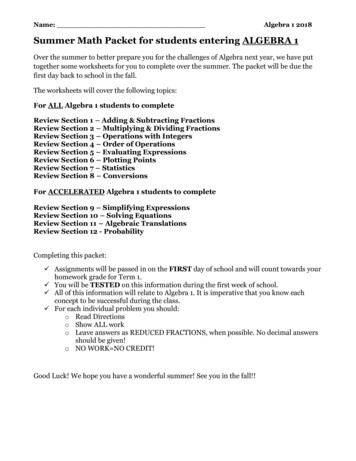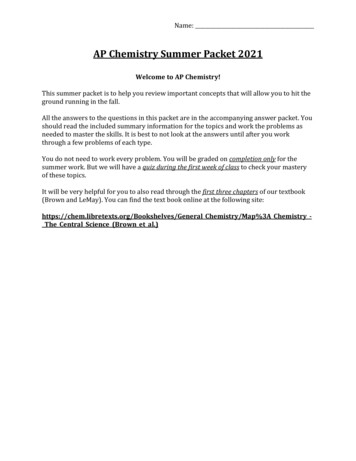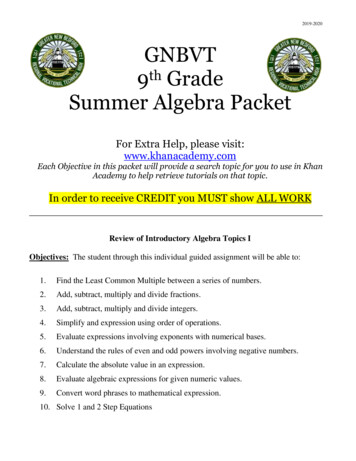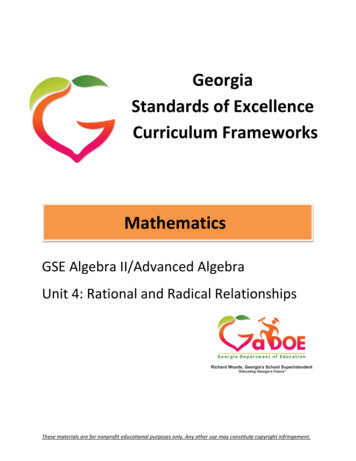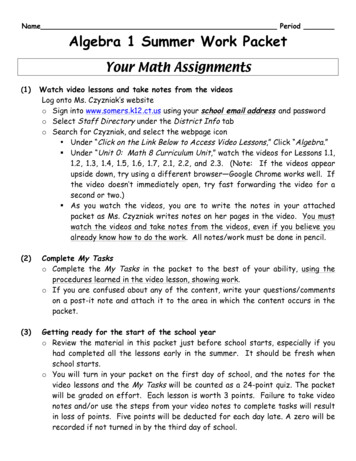
Transcription
Name PeriodAlgebra 1 Summer Work PacketYour Math Assignments(1)Watch video lessons and take notes from the videosLog onto Ms. Czyzniak’s websiteo Sign into www.somers.k12.ct.us using your school email address and passwordo Select Staff Directory under the District Info tabo Search for Czyzniak, and select the webpage icon Under “Click on the Link Below to Access Video Lessons,” Click “Algebra.”§ Under “Unit 0: Math 8 Curriculum Unit,” watch the videos for Lessons 1.1,1.2, 1.3, 1.4, 1.5, 1.6, 1.7, 2.1, 2.2, and 2.3. (Note: If the videos appearupside down, try using a different browser—Google Chrome works well. Ifthe video doesn’t immediately open, try fast forwarding the video for asecond or two.)§ As you watch the videos, you are to write the notes in your attachedpacket as Ms. Czyzniak writes notes on her pages in the video. You mustwatch the videos and take notes from the videos, even if you believe youalready know how to do the work. All notes/work must be done in pencil.(2)Complete My Taskso Complete the My Tasks in the packet to the best of your ability, using theprocedures learned in the video lesson, showing work.o If you are confused about any of the content, write your questions/commentson a post-it note and attach it to the area in which the content occurs in thepacket.(3)Getting ready for the start of the school yearo Review the material in this packet just before school starts, especially if youhad completed all the lessons early in the summer. It should be fresh whenschool starts.o You will turn in your packet on the first day of school, and the notes for thevideo lessons and the My Tasks will be counted as a 24-point quiz. The packetwill be graded on effort. Each lesson is worth 3 points. Failure to take videonotes and/or use the steps from your video notes to complete tasks will resultin loss of points. Five points will be deducted for each day late. A zero will berecorded if not turned in by the third day of school.
Paperwork to Turn In(1)Academic Policies and Flipped Classroom pagesReview the attached Academic Policies and Flipped Classroom pages with yourparents.(2)Student Information SheetComplete the top section of the last page of this packet, the Student InformationSheet, and ask your parent or guardian to complete the bottom section. The backside is for teacher use only.Required Daily Materials*The following is a list of materials that you are expected to bring to class every day,starting on the first day of school. There may be a graded “materials check” on thefirst day of school as well as unannounced graded checks throughout the year. ScientificCalculator (Although any scientific calculator is acceptable, the recommendedscientific calculator for 8th grade and for the high school is TI 30XIIS. With a marker,write your full name (not initials) somewhere on your calculator and on the inside ofyour case!!!! 2 Sharpened Pencils BlockEraser 3-RingBinder Rulerwith Both Standard and Metric Measures. (Note: plastic rulers snap/break veryeasily—wooden or flexible rulers are more durable). Highlighters Earbuds Chromebook (after distribution by the school)*If it would cause a financial hardship to obtain any of these supplies, please have yourparent/guardian confidentially email Ms. Czyzniak, and she will ensure you have what you need.
Unit 0, Math 8 Curriculum, Part APart 1 :Part 2:Real NumbersPythagorean TheoremPart 1: Real NumbersLesson PST 1.1 Rational and Irrational NumbersReal Numbers consist of rational and irrational numbers.Rational NumbersIrrational NumbersWritten as ratio of two integers1.5Cannot be written as ratio of two integers71.750.30.0010.111 0.51349.524IntegersA non-fractional number that can bepositive, negative, or zero.-53813,043-97Whole NumbersAll positive numbers, including zero,that do not include any fractional ordecimal parts when simplified13854,3970Natural (or Counting) NumbersThe whole numbers excluding zero1953π99 2 70.01001000100001000001
Unit 0, Part 1: Real NumbersMy Task: PST 1.1 Rational and Irrational NumbersWhat type(s) of numbers are the following? Circle all that apply. (Remember to simplify alwholeintegerrationalirrationalrealWhich set of numbers is the most reasonable for the following situations and why? (Alwaysdetermine if fractions/decimals, zero, or negatives would make sense in the situation.)6. The number of desks in a 7. Heights of your classmates. 8. The temperature on aroom.thermometer.
Review: How to Convert a Decimal to a Ratio (Fraction)Convert 0.75 to a fractionStep #1: Write the decimal as a fraction over 1:0.751Step #2: Multiply the top and the bottom by 10 for every number after the decimal point.(If you have 1 digit after the decimal point, multiply the top and bottom by 10;2 digits, by 100; 3 digits, by 1000; 4 digits, by 10000, )Since 0.75 has 2 digits after the decimal point, multiply by 100 0.75 100 751 100 100Step #3: Simplify (or reduce), if possible. The Greatest Common Factor (GCF) of 75 and100 is 25, so divide the numerator and the denominator by 25.75 ! 25 3#& 100 " 25 % 25Write each number as a ratio using integers to show that it is a rational number. Refer tothe steps in the example above for guidance. Always simplify your fractions.9.0.410.-611.15.112.1.313.-2414.-2.024
Unit 0, Part 1: Real NumbersLesson PST 1.2: Changing Repeating Decimals to FractionsReview: Convert a Fraction to a Terminating DecimalA review . . . two methods for converting from a fraction to a terminating decimal (a decimalthat ends).Using Long DivisionUsing a Calculator(required for Quiz 1.1 – 1.3!)33Before we begin . . .Convertto a decimal using long division.Convertto a8816decimal using a3Some terminology . . .calculator.Any fraction is just adivision problem!Divide top down!Review: Convert a Terminating Decimal to a FractionA review . . . converting a terminating decimal (a decimal that ends) to a fraction. [Everyterminating decimal can be expressed as a fraction, so terminating decimals are rationalnumbers.]Convert -33.591 to a fraction.
Convert a Repeating Decimal to a FractionNew material . . . converting a repeating decimal (adecimal that has a digit, or a block of digits, thatrepeat over and over and over again without everending) to a fraction. [Every repeating decimal canbe expressed as a fraction, so repeating decimals,like terminating decimals, are rational numbers.]ChangeLetto a fraction.0.36to a fraction.x 0.4444 ChangeChangeKi ]0.40.16 to a fraction. (Doozie!)A repeating decimal has digits that repeat forever.
Unit 0, Part 1: Real NumbersMy Task: PST 1.2 Changing Repeating Decimals to FractionsChange0.7 to a fraction.Change0.24to a fraction.Change0.54to a fraction.
Unit 0, Part 1: Real NumbersLesson PST 1.3: Approximating Square RootsWhat is a “perfect square?”Taking a positive integer and squaring it (multiplying it by itself)equals a perfect square.Example: 3 x 3 9 Thus: 9 is a perfect square.Performing the inverseoperation of squaring anumber is finding theSquaring an integerresults in the followingPerfect SquaresIntegerSquare Root12 122 432 942 1652 2562 3672 4982 6492 81102 100112 121122 144502 25001002 10,00010002 1,000,0001234567891011125010010001 14 29 316 425 536 649 764 881 9100 10121 11144 122500 5010000 1001000000 1000These are the locations of perfect squares on a number 400
Approximating a Square 00Use the number line above to simplify the following square roots256815349Since 53 is not a perfect square, we cannot simplify 53 to a whole number like we canwith perfect squares! We have a method to approximate (estimate) square roots of nonperfect squares, but the method is a doozie!(1)Identify where1491653 would appear on the number line 2)Write an equality to identify between which twosquare roots 53 would appear, then simplifythe square roots immediately surrounding 53 .(3)So(4)But let’s be more precise and round to the nearest tenth. Is 53 approximately 7.1?7.8? 7.5? We need to guess and check by squaring the values between 7.0 and )Let’s be even more precise and round to the nearest hundredth. Is 53 approximately7.23? 7.21? 7.29? We need to guess and check by squaring the values between 7.20 and7.30.7.202 7.212 7.222 7.232 7.242 7.252 7.262 7.272 7.282 7.292 7.302(6)What is the approximate value ofthe nearest hundredth?53 is a decimal between and .53 , rounded toReal-World Link
Gravity. Legend states that while sitting in his garden one day, Sir Isaac Newton was struck onthe head by an apple. Suppose the apple was 64 feet above the ground. How long did it takethe apple to fall?hto answer the question.4This formula can be used to find the time, t, in seconds that itwill take an object to fall from a certain height, h, in feet. Let’ssubstitute 64 into the formula in place of h to find the answer.We are going to use a formula t t suppose the apple wasn’t 64 feet, or 49 feet, or 25 feet or any other “perfect square” feetabove the ground? What if the apple was 19 feet above the ground? 19 is not a perfectsquare. How can you approximate 19 so that you can still use the formula to find the numberof seconds for the apple to fall? Round to the nearest hundredth.Step 1: Find between which two perfect squares the 19 falls.1Step ound to the nearest tenth. Guess and Check.What 2 values surround 19 ? Square: 4.0, 4.1, 4.2, 4.3, 4.4, 4.5, 4.6, 4.7, 4.8, 4.9 p 3: Round to the nearest hundredth. Guess and Check.Is 19 closer to 4.30, 4.31, 4.32, 4.33, 4.34, 4.35, 4.36, 4.37, 4.38, 4.39 or 4.40?4.302 4.312 4.322 4.332 4.342 4.352 4.362 4.372 4.382 4.392 4.402Step 4:Answer the question.Real-World Link, #2
Animals . The maximum speed, s, that an animal can walk in feet persecond is s 5.66 l , where l represents the animal’s leg length, in feet.What is the maximum speed that a giraffe can walk if it’s leg length is11 feet?Step 1: Find between which two perfect squares the 11 falls.1Step 2:49162536496481100121144169196225Round to the nearest tenth. Guess and Check.Step 3: Round to the nearest hundredth. Guess and Check.Step 4: Answer the question.Unit 0, Part 1: Real NumbersMy Task: PST 1.3: Approximating Square Roots256289324361400
1. Approximate each square root to the nearest whole number, the nearest tenth, and thenearest hundredth using the method in lesson 1.3.9032452.Approximate 5 and6 below. Show all work.
Approximate5 to the nearest hundredth.Approximate6 to the nearest hundredth.3.Use your approximations of 5 and 6 to plot them on the number line below. (Write anappropriate scale of numbers for the markings on the line.)4.Complete the comparative statements.5 is between the whole numbers and .5 is approximately less than6.6 is between the decimals (in tenths) and .
Unit 0, Part 1: Real NumbersLesson PST 1.4: Integer Powers of 10 and Exponential NotationWhat is a number raised to the zero power?1032310222101211002010-12-110-22-210-32-3The expression of a number using the decimal system(base 10) is called its expanded form using powers of10. In this system, each "decimal place" consists of adigit 0 - 9 (the decimal digit) arranged such that eachdigit is multiplied by a power of 10, decreasing from leftto right, and with a decimal place indicating the 100 1for the one’s place. For example, to expand the number62904.53 using powers of 10:Write the following in expanded notation using powers of 10: 79042.835You Try: Write the following in expanded notation using powers of 10: 2,043,506.78
Exponential NotationDrake sold 3,000,000 song downloads last year. Your friend says that 3,000,000 is the same as3 · 10 · 10 · 10 · 10 · 10 · 10Is your friend correct?Demonstrate below another way to represent 3,000,000using 3’s and 10’s (hint: exponents)?Exponential notation is asimplified way to representrepeated multiplication. Forexample,Basic Rules of Exponents: Generating Equivalent Numerical ExpressionsExponential Rule4Example23 3 34 2You try . . .6 3 72923 27(34)2 34 2 38 6,561(23)73 4 13 43533134 181 34 81 35 3 32 92 312 32723
Let’s Practice1.2.3.4.5.6.435252 5518 3676343474 352You try . . .3 2547.598.64
Unit 0, Part 1: Real NumbersMy Task: PST 1.4: Integer Powers of 10 and Exponential Notation1. What is the value of 50?2. What is the value of 34759660?Write the following in expanded notation using powers of 10.3.6,231.34.985,241,018.765.412.367416. Write the following in exponential notation:3 3 3 3 3 3 37.Demonstrate the number below in 4s and10s:40,000Use the properties of exponents to generate equivalent numerical expressions.8.10.12.14 241 4 598949.11.13.727362332 34 5
Unit 0, Part 1: Real NumbersLesson PST 1.5: Scientific Notation and Operations With Scientific NotationScientific NotationScientific notation is a shorthand way of writing very small or very large numbers so that theyare easier to compare or used in computations.Review: Multiplying by the powers of 107.82 times 107.82 times 1007.82 times 105Scientific NotationNumberbetween 1and 10Examples:xAn integerpower of105.2 x 1038 x 1093.772 x 10-2Writing a large number in scientific notation.Writing a small number in scientific notation.65,300,000,0000.0000583Reversing the Process—from Scientific Notation to Standard FormWrite the number below in decimal form.Write the number below in decimal form.8.136 x 10104.9107 x 10-3Have you ever seen these on a calculator?3.21 E 97.8 E -5
Operations with Scientific NotationDrop the larger exponent down to the degree of thesmaller exponent. Determine the number of powers of 10that was reduced. Then, to compensate for the reducedvalue of the exponent, move the decimal point in thecoefficient to the right one unit for every power of ten thathad been reduced. Rewrite the numbers in the expression.
Unit 0, Part 1: Real Numbers1.My Task: PST 1.5: Scientific Notation and Operations With Scientific Notation2302.56 million3.3.02 x 10-54.8.9 x 1077.The table contains several measurements written in decimal and scientific notation.(A)(B)5.0.0000486.12 thousandthsComplete the table so that each measurement is written in both decimal andscientific notation.In the last column, rank the measurements in order of size (1 smallest, 2 nextsmallest, and so on up to 7 largest).
Use the methods from this lesson to simplify the following operations involving scientificnotation expressions.8.(2.1 x 103) (4 x 105)9.(1.4 x 108) – (3.3 x 102)10.(6.3 x 102)(8 x 105)12.(4.32 x 105) – (2 x 10) (DOOZY!)14.(9.7 x 104)(5.51 x 108)11.(8.8 x 10 9 )(2.2 x 10 2 )13.(6.4 x 10 3 )(Doozy!)(3.2 x 10 4 )15.(3 x 103) (4.8 x 10-1)
Use appropriate scientific notation operation rules to find the following. Round to the nearesttenth, when appropriate.16. The population of Mathville is 5.6 x 103. The population of Algebraland is 1.3 x 104. Howmany times greater is one town than the other? Be specific with your response.17. By area Greece has 5.1 x 104 square miles of area. The United States has approximately3.8 x 106 square miles of land. How many more square miles of land does the United Stateshave than Greece?18. The mass of the sun is 1.989 x 1030 kilograms. The mass of the earth is 5.98 x 1024kilograms. How many times bigger is the sun than the earth?19. At 186,282 miles per second, how far does light travel in a year? Give your answerin miles, but use scientific notation. A year is approximately 365.25 days.The answer to this question is called a light year by astronomers, who use it to measure huge distances. Otherthan the sun, the star nearest the earth is Proxima Centauri, a mere 4.2 light years away.
Unit 0, Part 1: Real NumbersLesson PST 1.6: Evaluate Square Roots of Perfect SquaresSquares12 122 432 942 1652 2562 3672 4982 6492 81102 100112 121122 144How do you “undo” addition?How do you “undo” division?How do you “undo” squaring?If x2 49, what is x?You try. If x2 7, what is x?
x 30 . Find x.2!2 Simplify ## &&"3%Simplify.464You try.x 4 . Find x.2!5 You try. Simplify ## &&"2%You try. Simplify81100
Unit 0, Part 1: Real NumbersMy Task PST 1.6: Evaluate Square Roots of Perfect SquaresYou try: Find x and check your answer.1.x2 1212.x2 10x 73.5.Simplify.1003624.6.!1 Simplify ## &&"3%Find a value for x and p that make theequation true.x2 p 1x p Check your answer below.
Unit 0, Part 1: Real NumbersLesson PST 1.7 Rational and Irrational NumbersCubes13 123 833 2743 6453 12563 21673 34383 51293 729103 1000113 1331123 1728What is an expandednotation for 63?What number multipliedby itself 3 times gives 8?What are the two waysof saying “93”?If x3 125, what is x?If x3 14, what is x?
3x 20 . Find x.3!2 Simplify ## &&"3%Simplify.32168You try.3x 9.1 . Find x.3!7 You try. Simplify ## &&"4%You try. Simplify31125
Unit 0, Part 1: Real NumbersMy Task PST 1.7: Evaluate Cubed Roots of Perfect CubesYou try: Find x and check your answer.1.x3 3432.x3 10033.5.Simplify.3x 151331100034.6.!4 Simplify ## &&"5%Find a value for x and p that make theequation true.x3 p – 2x p Check your answer below.
Part 2: Pythagorean TheyoremLesson PST 2.1: The Pythagorean Theorem and Proofs of the Pythagorean TheoremThe Babylonians knew about the sets of numbers now called Pythagorean Triples—sets ofpositive numbers such that a2 b2 c2. Right triangles have the property known today as thePythagorean Relationships.The Pythagorean TheoremIn a triangle, the sum of thesquaresofthelengthsoftheis equal to the square of thelength of the .Notice that the side opposite the rightangle in the triangle is the longest. This istrue in all right triangles. This side is calledthe hypotenuse.a2 b2 c2symbol: If the Δ is a right Δ, then a2 b2 c2One Proof of the Pythagorean TheoremBuild squares on all sides of the triangle.
Let’s Practice the Pythagorean Theorem1.Find the length of the missing side.3. You try. Find the length of the missing side.2.4.Find the length of the missing side.Find the length of the missing side.1595.Find the length of the missing side.6. You try. Find the length of the missing side.
Unit 0, Part 2: Pythagorean TheoremMy Task: PST 2.1 The Pythagorean Theorem and Proofs of the Pythagorean TheoremFind the value of x. Remember to label the sides a, b, and c. Then determine if you are findinga missing leg length or a missing hypotenuse length. Set up your equation and solve!1.2.13.4.3
Unit 0, Part 2: Pythagorean TheoremLesson PST 2.2: The Pythagorean Theorem in Real-Life Situations1.A hiker leaves camp and follows the route shown. Howfar is she from camp?11 milesduesouth14 miles due east2.The following is a rule of thumb for safely positioning aladder. The distance from the bottom of the ladder to thewall should be one-fourth the length of the ladder. Thus, thebottom of a 16-foot ladder should be 4 feet from the wall.How far up the wall will the ladder reach?
3.The mobile phone company is anchoring 4.wires to the top of their 1200 ft highcommunication towers. The cable for thesupport wire comes in a roll that is 3900ft long. The company requires you to usethe entire roll. The cable can only be cuttwice to ensure its strength. All cablesneed to be equal. How long will each cablebe and how far from the base of the towerdo they need to be anchored?In the city planning meeting, a scaledrawing of a park was drawn. The parkfalls inside a square city block. The scalewas 3 inches equal 3/10 miles. One side ofthe city blocks was 4 inches in thedrawing. One member of the city plannerssaid, "There needs to be a shortcutthrough the park from the corners." Howlong in miles will the short cut be? Roundanswers to the nearest tenth of a mile.3 in 3/10 miles
Unit 0, Part 2: Pythagorean TheoremMy Task: PST 2.2: The Pythagorean Theorem in Real-Life Situations1. How high up thebuilding does theladder reach?2. How far away from the truck is the bottomof the ramp?3. How high above the ground is the kite?4. You are locked out of yourhouse, and the only openwindow is on the secondfloor, 20 feet above theground. You need to borrowa ladder from one of yourneighbors. There’s a bushalong the edge of the house, so you willhave to place the ladder 15 feet from thehouse. What length of ladder do you needto reach the window?
5. A baseball diamond is a6. A suitcase measures 24 inchessquare with sides of 90long and 18 inches high. Youfeet. What is the shortestwould like to pack a 28-inch-longdistance, to the nearestumbrella in your suitcase. Willtenth of a foot, between the first base andyour umbrella fit in this suitcase? Explain.third base?7. Two joggers run 8 miles northand then 5 miles west. Whatis the shortest distance, tothe nearest tenth of a mile,they must travel to return totheir starting point?8. Jill’s front door is 42 inches wide and 84inches tall. She purchased a flat table topthat is 96 inches in diameter. Will thetable fit through the front door?
Unit 0, Part 2: Pythagorean TheoremLesson PST 2.3: The Pythagorean Theorem in a Coordinate SystemApply the Pythagorean Theorem to find the distance between two points in a coordinate system.1. Find the length of the hypotenuse below.2.Find the length of the hypotenuse below.
3.Find the distance between (-3, 5) and (-5, -5).4.Find the distance between (5, 2) and (1, -3).
You try: Apply the Pythagorean Theorem in the coordinate system to find the length of thesegment.1. Find the distance between the points.2. Find the distance between the coordinates (9, 8) and (-6, -7)
Unit 0, Part 2: Pythagorean TheoremMy Task: PST 2.3: The Pythagorean Theorem in a Coordinate System1.2.
3.4.
5. Find the distance between points (6, -2) and (-3, 3).6. Find the distance between points (-1, 7) and (8, 4).
Carefully Review theFollowing Pages, and Youand Your Parents are toComplete the Front Side ofthe Student InformationSheet
Name School YearMs.Czyzniak’s Academic Policies and Classroom Expectations—Algebra 1Welcome to Algebra 1!!! Please remember that successfully passing this course will result in a high school math credit.Therefore, the material will be rigorous and challenging and matched to the abilities and achievement levels of high-ability students.Units to be covered this year, which follow Connecticut’s Curriculum Design for Common Core Standards (CCS)Unit 0Math 8 CurriculumUnit 4Linear FunctionsGradingUnit 1PatternsUnit 5Scatterplots and Trend LinesUnit 2Linear Equations and InequalitiesUnit 6Systems of Linear EquationsUnit 3FunctionsUnit 7Beyond Linear FunctionsGrades are updated frequently. Check your grade often in the electronic grade book to ensure that all assignments havebeen submitted and accurately recorded. The integrity of assessments has to be maintained year-to-year, soassessments cannot leave room 403. These assessments are available for your review at any time in theclassroom, and arrangements can be made for parents who request to see their child’s scored assessments.Assignments will be graded as follows:Graded AssignmentsAll graded work is based on the numberof points assigned to each problem. For 28 0.8 80%example, if you took a quiz worth 35points and you earned 28 points, you can 35calculate your percent grade as shown: Quarter GradesQuarter grades are determined by 245 0.817 81.7%dividing the total points you earned inthe quarter by the total points assigned 300that quarter. For example, if assignments in the quarter totaled300 points and you earned 245 points, then your quarter gradewould be as shown.If you are absent for any graded assignment, an “ABS-0” will be recorded in the electronic grade book. The “ABS-0” codecalculates a zero for the assignment until the assignment is completed and the actual grade entered.Cheating or copying work/answers will result in a grade of zero for the assignment for all involved parties, and parents andschool administration may be notified of such a breach of academic integrity. Understand . . . if you allow another student tocopy your work or even if you fail to protect your work from being copied, you, as well as the copier, will earn a zero.Homework. Unless we are in the flipped classroom, homework, unless otherwise announced, will be due the next school day, at the(1)(2)(3)(4)(5)start of class, and points will be awarded based on completion, effort, and neatness. All homework must always be:Done in pencil. Math work is neater and easier to follow when done in pencil than when done in ink. Points will be deducted ifwork is not done in pencil.Thorough. You are required to show all work directly on the homework paper. If you used a calculator to help you solve, thekeystrokes that you input should be included in your work. Your work helps YOU pinpoint exactly where mistakes occur.Complete. All solutions do not have to be correct, but all problems must be attempted with “sincere effort.” Completely skippinga problem(s) will result in point deduction.Ready at the start of class. No late homework will be accepted unless it had been assigned on the day of an excused absence.Corrected as it is being reviewed in class.Absences & Missed Work : See reverse side for details.Required Daily Classroom Materials2 UnitChromebook ScientificBlock3-RingDry EraserSharpenedRulerHighlighter(s)Packet& Earbuds CalculatorEraserBinder(old sock!)Pencils9th Grade Recommendations Will be Based on Your Final GradeFinal Grade in Algebra ICredit9th-Grade Math Recommendation86.5% or higherWill Earn a High School CreditHonors Geometry70% - 86.4%Will Earn a High School CreditGeometry60% - 69.9%Will Earn a High School CreditStudents who earn below a C- are recommended to repeat(without additional credit) Algebra I to ensure a properfoundation for future math classes. However, the final decisionfor course selection will rest with the student’s parents.Below 60%Will NOT Earn a High School CreditAlgebra I
When You Are Absent . . . Making up missed work is YOUR responsibility!.Lessons: All of my lessons are on videos. If you are absent from school yet feeling well enough, youshould check my lesson plans to see what lesson is scheduled, watch the video lesson, and complete thehomework assignment to be current!Homework Assignments: (in the non-flipped classroom) If you were present for class on the date the assignment was announced but absent on the daythe assignment was due, you are expected to turn in the work at the start of class on the dateof your return. If you were absent on the date the assignment was announced, you have 5 SCHOOL DAYS toturn it in upon return to school, or a zero will be recorded. Do not expect your teacher toremind you that you have an outstanding assignment. Any homework assigned prior to an absence is expected to be turned in immediately uponreturning to school.Test or Quiz REVIEWS: Being absent from a test or quiz REVIEW does not grant a postponement ofthe assessment date. If you were notified of the test date in advance and you are present in school onthe date of the test/quiz, you will be expected to take the assessment with your classmates.Test or Quiz: If you were notified of a test or quiz date in advance and were absent on the date ofthe assessment, you may be expected to take the test or quiz on the day you return to school, so beprepared.(Note: Flexibility will be exercised for lengthy absences.)All deadline dates are firm for long-term assignments. Please understand that it is yourresponsibility to turn in long-term assignments on or before the deadline date, even if you are absenton the final date for submission. Out of fairness to your peers who have completed theseassignments on time, please do not request or ask a parent to request an extension. Try to be at leasttwo days ahead just in case. Be responsible!Question: “When are we ever going to use this math in real life?”Answer: Math teachers understand that at times math seems irrelevant and disconnected from yourpersonal world. And it is true that you will probably never use some algebra skills in your day-to-daylife. But learning math goes beyond the skills themselves. While you are practicing these skills, yourbrain is getting stronger and you are improving your ability to think logically! That is, math tasks willhelp you to learn how to think ideas through in a sequential, rational manner, supporting your capacitiesto make sound decisions—in all areas of your life.Furthermore, do you want to have a successful career? Most good jobs require some form ofmath aptitude, especially jobs involving a solid ability to reason, such as those in the fields of medicine,architecture, finance, science, law, engineering, business, public protection, etc.Stick with math because your brain is getting a necessary and fantastic workout!Everyone Can Learn and Excel at MathAn embarrassing fact: The United States is the only advanced industrialnation where people are quick to say, “I am not good in math.” People wouldbe terribly offended if you ever called them illiterate but may laugh if you called them innumerate(unable to do arithmetic). Let’s change that! Don’t fall into the trap of thinking that learn
Part 1: Real Numbers Lesson PST 1.1 Rational and Irrational Numbers Real Numbers consist of rational and irrational numbers. Rational Numbers Written as ratio of two integers 1.5 7 0.3 1.75 0.001 0.111 0.51 9.5 3 4 4 Irrational Numbers Cannot be written as ratio of two integers π 3 99 2 27 0.0100100010 00010 001 Integers
